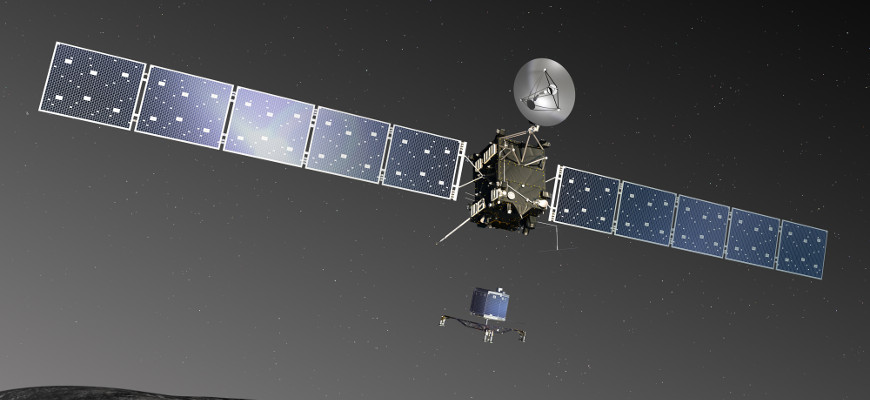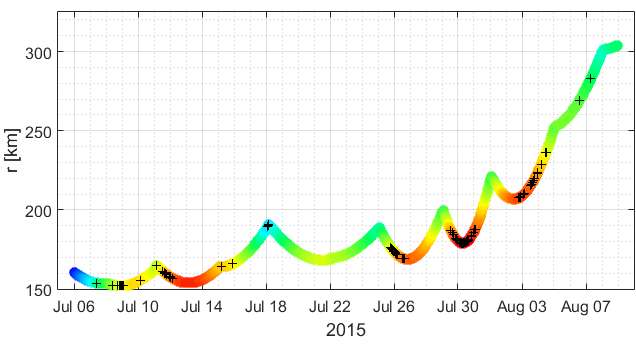Space Physics Research Group

Group leader: Zoltán Németh
Group website: wigner.hu/en/space-physics
Our research group is mainly focused on space plasma physics and space weather. Our activities are strongly related to space missions by ESA, NASA and the Russian Space Agency. We process spacecraft data and provide theoretical interpretation. Besides research, we find it important to preserve and transfer knowledge. As information on the current developments in the field of space research is very popular with the public, we often engage in media outreach. Our educational activities include theoretical and laboratory courses in Solar System Physics. Our team members supervise PhD, MSc and BSc students.
Currently we are involved in five major projects: EU H2020 and H2024 Europlanet, ESA Cluster Hungarian Data Center, ESA Solar Orbiter, ESA JUICE and an OTKA grant (Hungarian Research Fund) for the research of the inner heliosphere (http://www.rmki.kfki.hu/~opitz/innerheliosphere).
The research group members are actively participating in the data analysis of the Cluster probes, the Cassini, Rosetta, STEREO, Venus Express, SOHO and the Ulysses space missions. We are also members of the BepiColombo and the Solar Orbiter science teams and we are involved in the development of the JUICE spacecraft as well.
Job opportunity:
OTKA "Inner heliosphere" junior research fellow:
October 2021 - March 2024
Requirements: MSc in related fields and enrollment in the doctoral programme
Contact: opitz.andrea@wigner.hu
Our fields of reseach:
Space weather - structure of the heliospheric magnetic field and variability of the solar wind structures
Space weather - interaction of the solar wind with the planetary plasma environments
The plasma environments of Saturn and Titan
Cometary science
Terrestrial magnetosphere
For more see: wigner.hu/en/space-physics
Teaching:
Physics of the Solar System (MSc, PhD)
Voyage through the Solar System (BSc)
Last modified by Andrea Opitz on 30th September 2020
WIGNER YEAR BOOK 2016
Andrea Opitz, Zsófia Bebesi, Melinda Dósa(P), Géza Erdős, Lajos Földy, Antal Juhász, Károly Kecskeméty, Péter Király(A), Zoltán Németh, Klaudia Szabó, Károly Szegő(E), Mariella Tátrallyay(A), Anikó Timár(P)
P Ph.D. student
A Associate fellow
E Professor emeritus
Solar System Bodies and Magnetospheres
Cometary physics. — The Rosetta spacecraft continued the exploration of the environment
of comet 67P/Churyumov-Gerasimenko. Our research group contributed to several
important results concerning the induced magnetosphere of the comet. We investigated the
interaction of the solar wind and the cometary plasma, and found several relationships
between the angular distributions of the interacting plasma populations. We also studied
the response of the cometary environment to the arrival of abrupt solar wind disturbances.
Our researchers participated in the discovery of the diamagnetic cavity of this comet (a
region around the nucleus, from which the strong cometary activity “blows away” the
magnetic field – a phenomenon observed only once at comet 1P/Halley earlier). We worked
out a method, which can be used to find diamagnetic cavity crossing events on a
magnetically dirty spacecraft, where residual fields render the usual methods very difficult.
We used this method to detect more than a hundred cavity crossing events, and to build an
event database. We analyzed the properties of these events, revealed and explained the
plasma signatures accompanying the crossing of the cavity boundary, described the
probable shape of the cavity and showed that an old model – refined and with proper input
parameters – provides a good fit for the average extent of the cavity (Fig. 1). We also
contributed to the discovery of a new type of plasma boundary; the analysis of the
distribution of suprathermal electrons; and to the study of magnetic pile-up and mirrormode
waves around the comet.
The magnetosphere and moons of Saturn. — Based on the observations of the Cassini
spacecraft we studied the magnetodisc of Saturn (a complex magnetized plasma
phenomenon, which influences almost every property of the magnetosphere of Saturn). In
addition to our contribution to a book, which reviews the properties of the magnetodiscs
and aurorae of giant planets, we have also found that the complex time dependence of the
magnetic and plasma measurements in the vicinity of the magnetodisc can be
simultaneously explained by a simple model, which takes into account the planetary period
oscillations (PPO) of the magnetodisc and the position of the spacecraft relative to the
central sheet of the magnetodisc.
Using Cassini observations, we have followed the orbital evolution of E-ring dust particles,
through their entire lifetime, starting at moon Enceladus, and ending in: a) a collision with
the A-ring or any of the satellites; or b) losing all their mass due to sputtering; or c) leave the
magnetosphere of Saturn. Using an updated version of our model (which included a noon-
midnight electric field in the magnetosphere and a refined plasma model) we calculated the
deposition rates and maps of E-ring particles to surfaces of the moons of Saturn.

The distance between Rosetta and the nucleus. Black + signs mark the sites where
Rosetta encountered the cavity; the color of the line represents the distance from the nucleus
in rcs units, where rcs is the time dependent theoretical boundary distance.
Space Weather
Space weather propagation. — Our analysis of the interplanetary magnetic field, measured
by satellites during the declining phase of the solar cycle 23, have shown that significant
modulation of the magnetic flux were present in association with the solar rotation. The
recurrent magnetic flux increases, lasting for several years, may have impact on the
terrestrial environment and can contribute to space weather events.
Space weather effects on Solar System bodies. — We participated in the statistical analysis
of global polarity reversals of the Venusian induced magnetosphere in response to the
polarity change in the interplanetary magnetic field; and also in a multi-instrument study of
the topside ionosphere of Mars under different solar wind conditions.
Suprathermal ions. — By studying the energy spectra of various ions at suprathermal
energies during quiet solar conditions in fast solar wind streams from near-equatorial
coronal holes we found that the bulk wind ions serve as a seed population subsequently
accelerated to high energies.
Grants
EU H2020 Europlanet-RI (Inclusiveness Officer & NA1 c. pers.: K. Szegő; JRA4 c. pers.: A.
Opitz, 2015-2019)
ESA PECS Rosetta RPC (K. Szegő, 2015)
ESA PECS Cluster Science Data System (M. Tátrallyay, 2015-2017)
János Bolyai Research Scholarship (Z. Németh, 2016-2019)
International cooperation
International team of the Cassini Plasma Spectrometer (CAPS) (K. Szegő, Z. Németh)
International team of the Cassini Magnetometer (MAG), (G. Erdős)
International team of the Rosetta Plasma Consortium (RPC) (K. Szegő, Z. Németh)
International team of the Cluster mission (M. Tátrallyay)
Europlanet2020-RI, integrating the European planetary science community (K. Szegő, A.
Opitz)
University of Colorado, Boulder, USA (A. Juhász)
Lomonosov Moscow State University, Russia (K. Kecskeméty)
Publications
Articles
1. Behar E, Nilsson H, Wieser G Stenberg, Németh Z, Broiles T W, Richter I: Mass loading
at 67P/Churyumov-Gerasimenko: A case study. GEOPHYS RES LETT 43:(4) 1411-1418
(2016)
2. Broiles TW, Burch JL, Chae K, Clark G, Cravens TE, Eriksson A, Fuselier SA, Frahm RA,
Gasc S, Goldstein R, Henri P, Koenders C, Livadiotis G, Mandt KE, Mokashi P, Németh
Z, Odelstad E, Rubin M, Samara M: Statistical analysis of suprathermal electron drivers
at 67P/Churyumov–Gerasimenko. MON NOT R ASTRON SOC 462:(Suppl_1) S312-S322
(2016)
3. Daibog E, Kecskeméty K, Lazutin L, Logachev Y: Jovian electrons as an instrument of
investigation of the interplanetary medium structure. J PHYS CONF SER 675
032024/1-4 (2016) International Conference on Particle Physics and Astrophysics
(ICPPA). Moscow, Russia, 05-10-2015 – 10-10-2015
4. Dálya Zs, Opitz A: Improvement of background solar wind predictions. GEOPHYS RES
ABSTR 18 145471-1 (2016) EGU General Assembly Conference Abstracts. Vienna,
Austria: 18-04-2016 – 22-04-2016
5. Vech D, Stenberg G, Nilsson H, Edberg N, Opitz A, Szegő K, Zhang T, Futaana Y: On the
global polarity reversal of the induced magnetosphere of Venus: a statistical study.
GEOPHYS RES ABSTR 18: 116/1-1 (2016) EGU General Assembly Conference
Abstracts. Vienna, Austria: 18-04-2016 – 22-04-2016
6. Edberg N J T, Eriksson A I, Odelstad E, Vigren E, Andrews D J, Johansson F, Burch J L,
Carr C M, Cupido E, Glassmeier K-H, Goldstein R, Halekas J S, Henri P, Koenders C,
Mandt K, Mokashi P, Németh Z, Nilsson H, Ramstad R, Richter I, Wieser G Stenberg:
Solar wind interaction with comet 67P: Impacts of corotating interaction regions. J
GEOPHYS RES-SPACE 121:(2) 949-965 (2016)
7. Goetz C, Koenders C, Richter I, Altwegg K, Burch J, Carr C, Cupido E, Eriksson A, Güttler
153
C, Henri P, Mokashi P, Németh Z, Nilsson H, Rubin M, Sierks H, Tsurutani B, Vallat C,
Volwerk M, Glassmeier K-H: First detection of a diamagnetic cavity at comet
67P/Churyumov-Gerasimenko. ASTRON ASTROPHYS 588 A24/1-6 (2016)
8. Mandt KE, Eriksson A, Edberg NJT, Koenders C, Broiles T, Fuselier SA, Henri P, Németh
Z, Alho M, Biver N, Beth A, Burch J, Carr C, Chae K, Coates AJ, Cupido E, Galand M,
Glassmeier K-H, Goetz C, Goldstein R, Hansen K C, Haiducek J, Kallio E, Lebreton J-P,
Luspay-Kuti A, Mokashi P, Nilsson H, Opitz A, Richter I, Samara M, Szegő K, Tzou C-Y,
Volwerk M, Wedlund CS, Wieser GS: RPC observation of the development and
evolution of plasma interaction boundaries at 67P/Churyumov-Gerasimenko. MON
NOT R ASTRON SOC 462:(Suppl1) S9-S22 (2016)
9. Németh Z, Burch J, Goetz C, Goldstein R, Henri P, Koenders C, Madanian H, Mandt K,
Mokashi P, Richter I, Timar A, Szegő K: Charged particle signatures of the diamagnetic
cavity of comet 67P/Churyumov–Gerasimenko. MON NOT R ASTRON SOC
462:(Suppl_1) S415-S421 (2016)
10. Németh Z, Szegő K, Földy L, Cowley SWH, Provan G, Thomsen M: Periodic motion of
the magnetodisk as a cause of quasi-periodic variations in the Kronian
magnetosphere. PLANET SPACE SCI 130:(1) 54-59 (2016)
11. Vech D, Stenberg G, Nilsson H, Edberg NJT, Opitz A, Szegő K, Zhang T, Futaana Y
Statistical features of the global polarity reversal of the Venusian induced
magnetosphere in response to the polarity change in interplanetary magnetic field
J GEOPHYS RES-SPACE 121:(5) 3951-3962 (2016)
12. Volwerk M, Richter I, Tsurutani B, Götz C, Altwegg K, Broiles T, Burch J, Carr C, Cupido
E, Delva M, Dósa M, Edberg N J T, Eriksson A, Henri P, Koenders C, Lebreton J-P,
Mandt K E, Nilsson H, Opitz A, Rubin M, Schwingenschuh K, Stenberg Wieser G, Szegö
K, Vallat C, Vallieres X, Glassmeier K-H: Mass-loading, pile-up, and mirror-mode waves
at comet 67P/Churyumov-Gerasimenko. ANN GEOPHYS 34:(1) 1-15 (2016)
13. Withers Paul, Matta M, Lester M, Andrews D, Edberg N J T, Nilsson H, Opgenoorth H,
Curry S, Lillis R, Dubinin E, Fränz M, Han X, Kofman W, Lei L, Morgan D, Pätzold M,
Peter K, Opitz A, Wild J A, Witasse O: The morphology of the topside ionosphere of
Mars under different solar wind conditions: Results of a multi-instrument observing
campaign by Mars Express in 2010. PLANET SPACE SCI 120 24-34 (2016)
14. Zel’dovich MA, Logachev YI, Surova GM, Kecskeméty K, Veselovskii IS: Suprathermal
ions in solar-wind outflows from coronal holes at 1 AU. ASTRON REP+ 60:(7) 687-693
(2016)
Book
15. Szegő K, Achilleos N, Arridge Ch, Badman S, Delamere P, Grodent D, Kivelson MG,
Louarn Ph (eds.): The Magnetodiscs and Aurorae of Giant Planets. Springer Verlag,
New York 2016. (Space Sciences Series of ISSI) 50. (ISBN:978-1-4939-3394-5)
Other
16. Szegő K: A Naprendszer kutatása az RMKI/RMI-ben (Research of the Solar System in
the RMKI/RMI). TERMÉSZET VILÁGA 147:(Special edition 2) 93-96 (2016)

